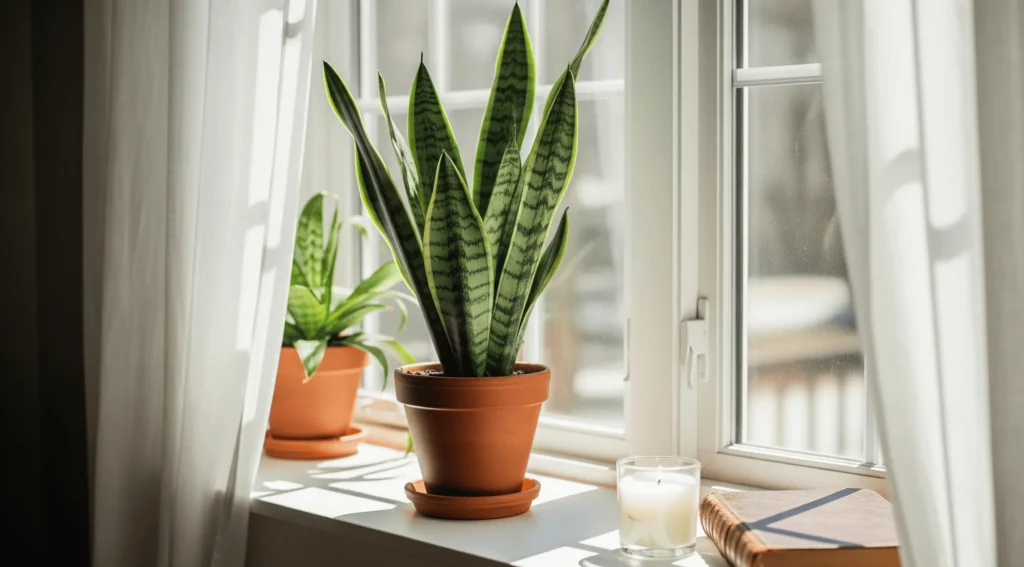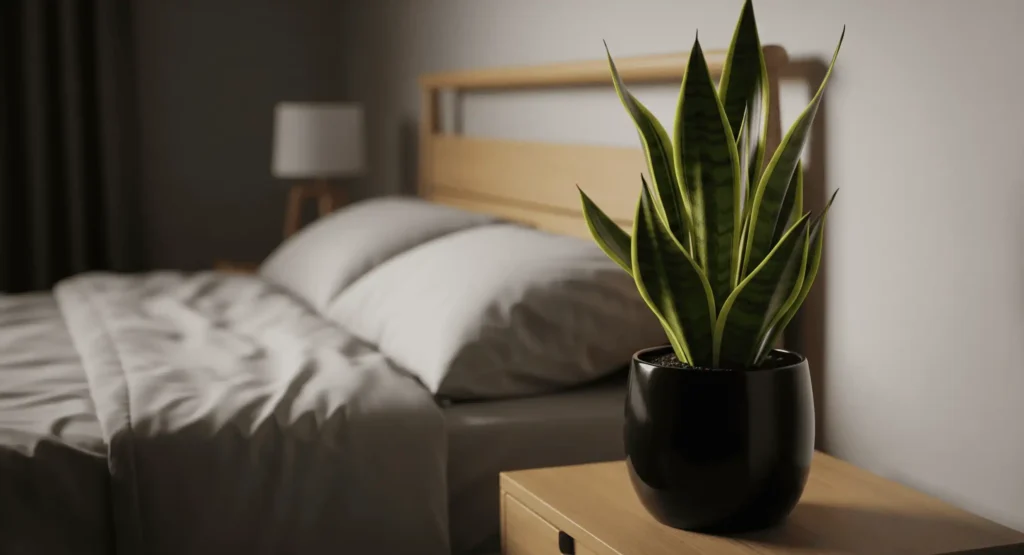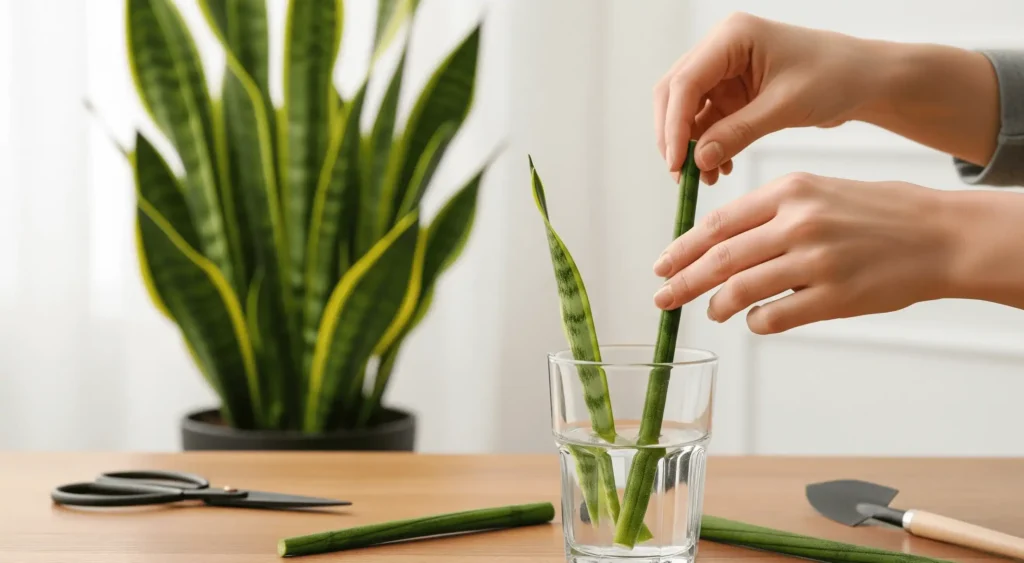Snake plants, scientifically known as Sansevieria, are hardy perennials native to West Africa, prized for their air-purifying qualities and striking, upright leaves. So, picture this: you’re scrolling Instagram, and there’s this sleek plant making a living room look effortlessly cool — that’s the snake plant stealing the show! With its bold, sword-like leaves, it’s a total survivor, thriving whether you’re a plant newbie or have a green jungle at home. Snake plants are excellent choices among various indoor living room plants. My first snake plant totally changed my space, giving it that cozy, alive vibe. This guide’s got you covered on why they’re so loved, how to care for them, and picking the perfect one for your place. Let’s dive in!

What is a Snake Plant?
Picture a plant that’s as low-maintenance as it is striking. That is the snake plant. Native to tropical West Africa, Sansevieria trifasciata (and its cousins) boasts long, upright leaves that often have green stripes or yellow edges, giving it that “snakes” vibe. Part of the Asparagaceae family, it’s an evergreen perennial that’s been a go-to houseplant for decades. Why? It’s practically indestructible. It can handle low light, infrequent watering, and still look fabulous. Plus, it’s got a reputation for purifying the air, as noted in NASA’s Clean Air Study, which found it removes toxins like formaldehyde and benzene. Oh, and in some cultures, it’s said to bring good luck. Not a bad resume for a plant, right?
Staying on top of the latest home decor trends, snake plants continue to be a popular choice for their timeless appeal.

Benefits of Snake Plants
So, why should you invite a snake plant into your home? Let’s break it down. First, they’re air-purifying champs. That NASA study we mentioned? It highlights how snake plants can scrub harmful toxins from the air, making your space healthier—especially if you’re in a city apartment with limited ventilation.
Then there is the low-maintenance factor. If you have ever forgotten to water a plant (who hasn’t?), this one’s for you. Snake plants can go weeks without a drink and still thrive. Their sleek, upright leaves also add a modern touch to any room, whether its your living room, and office, or even a bathroom. If you love the aesthetic but you are not ready for the real deal, high-quality fake plants can offer a similar vibe with zero upkeep. I remember placing my first snake plant in a corner of my apartment—it instantly made the space feel more put-together.
Another cool perk? Snake plant release oxygen at night, unlike most plants that do this during the day. This makes them a great pick for bedrooms, potentially improving air quality while you sleep. And if you re into feng shui, some believe they bring positive energy and protection. As one X user put it, “My snake plant’s been my vibe-lifter for years!” (@plantlover123).

Types and Varieties of Snake Plants
Not all snake plants are the same, and that is part of the fun. There’s a variety for every style, from bold and classic to modern and minimalist. Here are some popular ones:
- Sansevieria trifasciata ‘Laurentii’: The classic snake plant, with dark green leaves, gray-green stripes, and bright yellow edges. It is a showstopper and perfect for adding height to a room.
- Sansevieria cylindrica:Known as the African spear plant, this one has cylindrical, tube-like leaves that give it a sculptural look. It’s great for a modern, minimalist vibe.
- Sansevieria trifasciata ‘Moonshine’: This variety has silvery-green leaves that almost glow, adding a soft, ethereal touch to your space. Its a bit less common but just as easy to care for.
- Sansevieria trifasciata ‘Hahnii’: also called the bird’s nest snake plant, this compact variety grows in a rosette pattern, making it ideal for small spaces or tabletops.
Each type has its own personality, but they all share that signature snake plant resilience. If you’re looking for a large snake plant to make a statement, check out options at places like The Sill, where they often stock taller varieties.

How to Care for Your Snake Plant
Caring for a snake plant is about as easy as it gets, but a few tips can keep it thriving. Since they are succulents, they store water in their leaves,, So they dont need much fuss. Here is the breakdown:
How Often to Water Snake Plant
Less is more here. Water your snake plant every 2-6 weeks, letting the soil dry out completely between waterings. Overwatering is the number one mistake and too much water can lead to root rot. In winter, when growth slows, you might water even less. If you are unsure, check the soil with your finger; if its dry a couple of inches down, it’s time for a drink. Using filtered water can help avoid fluoride buildup, which can cause brown tips.
Snake Plant Soil
Good drainage is key. A cactus or succulent mix, like the one from Espoma, works wonders because it lets water flow through quickly. You can also mix regular potting soil with perlite or sand for a DIY version.Just make sure the soil does not stay soggy – your plant will thank you.
Light
Snake plants are super adaptable. They can handle low light, making them great for dim corners, but they prefer bright, indirect light. A spot near a window with sheer curtains is ideal. Direct sunlight, though, can scorch the leaves, so keep them out of harsh rays.
Temperature
These plants like it warm, between 60-85°F (15-29°C). They’re not fans of cold drafts or sudden temperature swings , So avoid placing them near air conditioning vents or frosty windows. If you ’re in a colder climate, keep them cozy indoors during winter.
How to Propagate Snake Plant
Want more snake plants for free? Propagation is a breeze. You can divide the plant when repotting, separating sectionss with roots, or try leaf cuttings. Cut a healthy leaf into 2-3 inch sections, let them callus over for a day, then plant them in soil or water until roots form. A propagation station, like the one from Terrain, can make this process even more fun. It is a great way to share plants with friends or grow your collection.

Is the Snake Plant Safe for Pets?
If you’ve got cats or dogs, you might be wondering about pet safety. According to the ASPCA, snake plant are mildly toxic if ingested, potentially causing nausea, vomiting , or diarrhea in pets. The good news? The toxicity is low, and serious issues are rare. still, it’s smart to keep your plant out of reach—think high shelves or hanging baskets.
On Reddit, pet owners often share tips for keeping snake plants and pets in harmony. One user noted, “My cat nibbled on my snake plant once, but it only caused mild discomfort. Now I keep it on a shelf, and we’re all good.” (r/houseplants). If you’re super cautious, you could opt for pet-safe plants like spider plants, but with a little care, snake plants can coexist with your furry friends.
Snake Plant Flowering
Did you know snake plants can flower? It’s rare indoors, but when it happens, its a treat. A healthy snake plant might produce a tall spike with small, fragrant, or white or cream-colored flowers. It’s a sign your plant is thriving, so give yourself a high-five if you see one. Don’t stress if it never flowers, though—it is still doing its job of looking great and cleaning the air.

Common Problems and Solutions
Even snake plants can hit a rough patch. Here are some common issues and how to fix them:
- Yellow Leaves: Usually a sign of overwatering. Let the soil dry out completely before watering again
- Brown Tip: Could be from too much fertilizer or fluoride in tap water. Use filtered water and fertilize sparingly, maybe once a month during growing season.
- Pests; spider mites or mealybugs are rare but possible. Wipe leaves with a damp cloth or use insecticidal soap.
- Root Rot:Caused by soggy soil. If you suspect it, remove the plant, trim rotten roots, and repot in fresh and dry soil.
With a little TLC, your snake plant will bounce back quickly.
Choosing the Right Snake Plant for You
Ready to bring a snake plant home? You have got options. Large snake plants, like those at Bloomscape, are perfect for filling a corner or making a bold statement in your living room. Smaller varieties, like the ‘Hahnii’, are great for desks or shelves. when shopping, look for firm, upright leaves with no yellowing. A stylish pot, like a ceramic one from West Elm, can make your plant pop. Check local nurseries or online retailers for the best selection.
For instance, a snake plant can be a perfect addition to your console table decor.

Final Words
Snake plants (Sansevieria) purify air and thrive with little care, making them ideal houseplants. Why do they stand out? They are resilient, stylish and fit any space, from dim corner to sunny rooms. Their unique varieties and easy propagation won me over, adding life to my home. I’m hooked on their low-effort charm! whether you want cleaner air or a chic vibe, they deliver. Ready to bring one home? Check out The Sill and start your snake plant journey today!
Here are some products mentioned throughout the post to help you get started with your snake plant journey:
| Product Name | Use Case or Placement | Price Range | Available At |
| Large Snake Plant | Floor plant for living room | $30 – $50 | Bloomscape |
| Cactus Soil Mix | For potting snake plants | $10 – $15 | Espoma |
| Ceramic Pot | Decorative pot for snake plant | $20 – $30 | West Elm |
| Propagation Station | For propagating snake plants | $15 – $20 | Terrain |
(Frequently Asked Questions) FAQs:
How big & tall do snake plants get?
Snake plants typically grow 2 – 4 feet tall indoors, with varieties like ‘Laurentii’ reaching up to 3 feet. Size depends on light and pot space
What is the meaning of Snake plant?
In some cultures, snake plants symbolize protection and good luck,often placed near entrances for positive energy, as noted in feng shui communities.
What are the medicinal uses of Snake plant?
Snake plants lack proven medicinal uses but improve air quality, potentially aiding sleep by releasing oxygen at night, per NASA’s Clean Air Study.
Is a snake plant a succulent?
Yes, snake plants are succulents, storing water in their thick leaves, Which makes them drought-tolerant and easy to care for.
Can we Snake plant for allergies?
Snake plants may reduce indoor allergens by purifying air , But there is no direct evidence they cure allergies, per NASA’s Clean Air Study.
What’s latin name Snake plant?
The Latin name for snake plants is Dracaena trifasciata (formerly Sansevieria trifasciata) , part of the Asparagaceae family.





